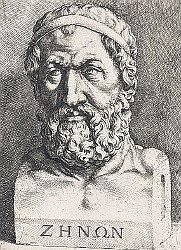1. The race
 In a race, the quicker runner can never overtake the slower, since the pursuer must first reach the point whence the pursued started, so that the slower must always hold a lead.
In a race, the quicker runner can never overtake the slower, since the pursuer must first reach the point whence the pursued started, so that the slower must always hold a lead.
Achilles and the tortoise agree to a race, where the tortoise is given a head start. Since Achilles is faster, he expects to overtake the tortoise soon. However the reasoning shown below “proves” that Achilles cannot even draw level with the tortoise, let alone overtake it!




 Little is known about Zeno but he was famed for his paradoxes and was clearly very mischievous.
Little is known about Zeno but he was famed for his paradoxes and was clearly very mischievous.
Achilles and the tortoise is indeed a classic case of a logical paradox, in which an “apparently plausible” line of reasoning leads directly to an absurd conclusion. In this particular case, we can be sure that the “apparently plausible” reasoning contains a flaw, because we know that Achilles can catch the tortoise. The question is only to pin down the flaw but this is easier said than done!
Let’s consider a simpler version of the paradox first, to see what we are up against. This one is also from Zeno. In this version, Achilles starts to walk towards a wall a short distance away but it can be “shown” that he can never reach the wall.





– Aristotle, Physics
Achilles and the tortoise agree to a race, where the tortoise is given a head start. Since Achilles is faster, he expects to overtake the tortoise soon. However the reasoning shown below “proves” that Achilles cannot even draw level with the tortoise, let alone overtake it!

Before he can draw level with the tortoise, Achilles must first reach the tortoise’s initial position. But in the time it takes him to do that, the tortoise will have advanced a little. (The tortoise is slow but not standing still.)

Achilles must then hurry on to the tortoise’s new position, but in that time the tortoise will have advanced still more.

Now Achilles must get to the tortoise’s latest position, but by then the tortoise will have edged on yet further.

There is obviously no end to this process and so Achilles can never draw level with the tortoise! Each time he gets to where the tortoise was, the tortoise is no longer there. Admittedly, Achilles may edge ever closer to the tortoise, but no matter how close he gets, he can’t quite catch up with the thing, let alone overtake it.This beguiling piece of reasoning comes from a famous philosopher named Zeno who lived around 450 B.C. in the ancient Greek settlement of Elea, now known as Velia in southern Italy.

Achilles and the tortoise is indeed a classic case of a logical paradox, in which an “apparently plausible” line of reasoning leads directly to an absurd conclusion. In this particular case, we can be sure that the “apparently plausible” reasoning contains a flaw, because we know that Achilles can catch the tortoise. The question is only to pin down the flaw but this is easier said than done!
Let’s consider a simpler version of the paradox first, to see what we are up against. This one is also from Zeno. In this version, Achilles starts to walk towards a wall a short distance away but it can be “shown” that he can never reach the wall.

Before Achilles can reach the wall he must of course walk half the distance to the wall. But obviously at that point he has not yet reached the wall.

Indeed he is effectively in his original state of being some distance from the wall – a lesser distance no doubt but still some distance.
So we can simply repeat our observation. Before Achilles can reach the wall he must walk half the (remaining) distance to the wall. But having done that he still hasn’t reached the wall.

And now the dilemma resurfaces. There is still some distance to the wall and before Achilles can reach the wall he must walk half this distance, whereupon he still has not reached the wall.

As before, this process may be repeated ad infinitum. Apparently then, Achilles can edge ever closer to the wall but never quite reach it!The resemblance to the tortoise should be clear. The main difference is that the tortoise is a moving target whereas the wall is a stationary one. Again, something is clearly wrong with Zeno’s reasoning since we know that Achilles can reach the wall. But the challenge is to attain a clear grasp of where the reasoning goes wrong. Let’s consider the wall first and return to the tortoise later.
Menu
 What’s a logical paradox?
What’s a logical paradox? Achilles & the tortoise
Achilles & the tortoise The surprise exam
The surprise exam Newcomb’s problem
Newcomb’s problem Newcomb’s problem (sassy version)
Newcomb’s problem (sassy version) Seeing and being
Seeing and being Logic test!
Logic test! Philosophers say the strangest things
Philosophers say the strangest things Favourite puzzles
Favourite puzzles Books on consciousness
Books on consciousness Philosophy videos
Philosophy videos Phinteresting
Phinteresting Philosopher biographies
Philosopher biographies Philosopher birthdays
Philosopher birthdays Draft
Draftbarang 2009-2025  wayback machine
wayback machine
 wayback machine
wayback machine
 Written in 2009.
Written in 2009. What Is the Answer to Zeno’s Paradox? (2014), by Brian Palmer.
What Is the Answer to Zeno’s Paradox? (2014), by Brian Palmer.